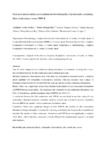Mostrar o rexistro simple do ítem
Pain assessment during eye examination for retinopathy of prematurity screening: skin conductance versus PIPP-R
| dc.contributor.author | Ávila-Álvarez, Alejandro | |
| dc.contributor.author | Pértega-Díaz, Sonia | |
| dc.contributor.author | Vázquez Gómez, Lorena | |
| dc.contributor.author | Sucasas-Alonso, Andrea | |
| dc.contributor.author | Romero Rey, Henar | |
| dc.contributor.author | Eiriz Barbeito, Dolores | |
| dc.contributor.author | Cabana Vázquez, Montserrat | |
| dc.date.accessioned | 2024-04-09T08:26:17Z | |
| dc.date.available | 2024-04-09T08:26:17Z | |
| dc.date.issued | 2020-05 | |
| dc.identifier.citation | Avila-Alvarez A, Pertega-Diaz S, Vazquez Gomez L, Sucasas Alonso A, Romero Rey H, Eiriz Barbeito D, Cabana Vazquez M. Pain assessment during eye examination for retinopathy of prematurity screening: Skin conductance versus PIPP-R. Acta Paediatr. 2020 May;109(5):935-942. | es_ES |
| dc.identifier.issn | 0803-5253 | |
| dc.identifier.uri | http://hdl.handle.net/2183/36106 | |
| dc.description | Observational study | es_ES |
| dc.description.abstract | [Abstract] Aim: To assess changes in skin conductance during retinopathy of prematurity screening and to study the correlation between the skin conductance and a validated pain scale. Methods: Prospective observational study. Fifty-three eye examinations were performed in 32 preterm infant candidates for retinopathy of prematurity screening. Outcome measures were changes in Premature Infant Pain Profile-Revised (PIPP-R) scale and number of skin conductance fluctuations. Results: There was a significant increase from baseline in the number of skin conductance fluctuations and PIPP-R during the procedure. The maximum value of number of skin conductance fluctuations was 0.64 ± 0.44 peaks/sec, and the maximum value of PIPP-R was 10.8 ± 3.3. A correlation between the skin conductance and PIPP-R was not found at any time during the eye examination. Repeated measures correlation analyses showed only a moderate positive correlation between PIPP-R and number of skin conductance fluctuation values. Conclusion: There were significant changes in both PIPP-R and number of skin conductance fluctuations during retinopathy of prematurity screening, reaffirming that this procedure is painful and stressful. The number of skin conductance fluctuations and PIPP-R are not significantly correlated, which likely reflects that these parameters evaluate different but complementary aspects of neonatal pain responses. | es_ES |
| dc.language.iso | eng | es_ES |
| dc.publisher | John Wiley & Sons | es_ES |
| dc.relation.uri | https://doi.org/10.1111/apa.15066 | es_ES |
| dc.rights | This is the pre-peer reviewed version of the article which has been published in final form at Acta Paediatrica. This article may be used for non-commercial purposes in accordance with Wiley Terms and Conditions for Use of Self-Archived Versions. | es_ES |
| dc.subject | Pain | es_ES |
| dc.subject | Premature infants | es_ES |
| dc.subject | Retinopathy of prematurity | es_ES |
| dc.subject | Skin conductance | es_ES |
| dc.subject | Stress | es_ES |
| dc.title | Pain assessment during eye examination for retinopathy of prematurity screening: skin conductance versus PIPP-R | es_ES |
| dc.type | info:eu-repo/semantics/article | es_ES |
| dc.rights.access | info:eu-repo/semantics/openAccess | es_ES |
| UDC.journalTitle | Acta Paediatrica | es_ES |
| UDC.volume | 109 | es_ES |
| UDC.issue | 5 | es_ES |
| UDC.startPage | 935 | es_ES |
| UDC.endPage | 942 | es_ES |
Ficheiros no ítem
Este ítem aparece na(s) seguinte(s) colección(s)
-
INIBIC- REUMA - Artigos [184]






